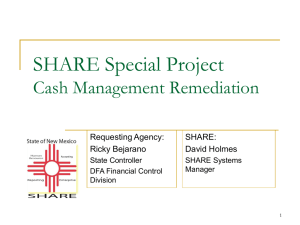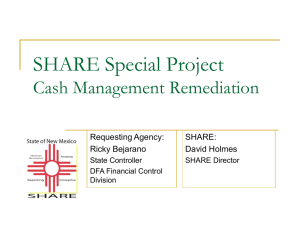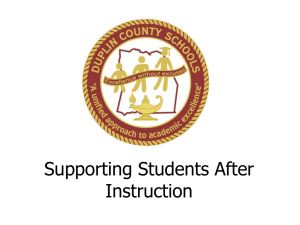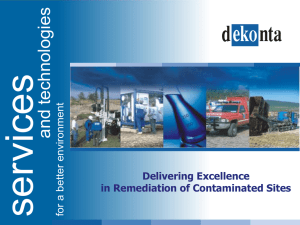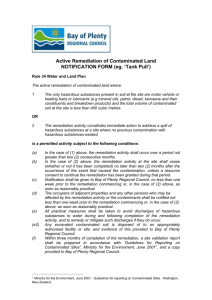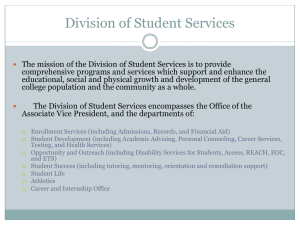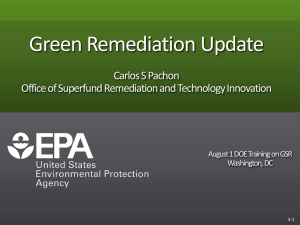Residents in Difficulty - Uniformed Services University of the Health
advertisement
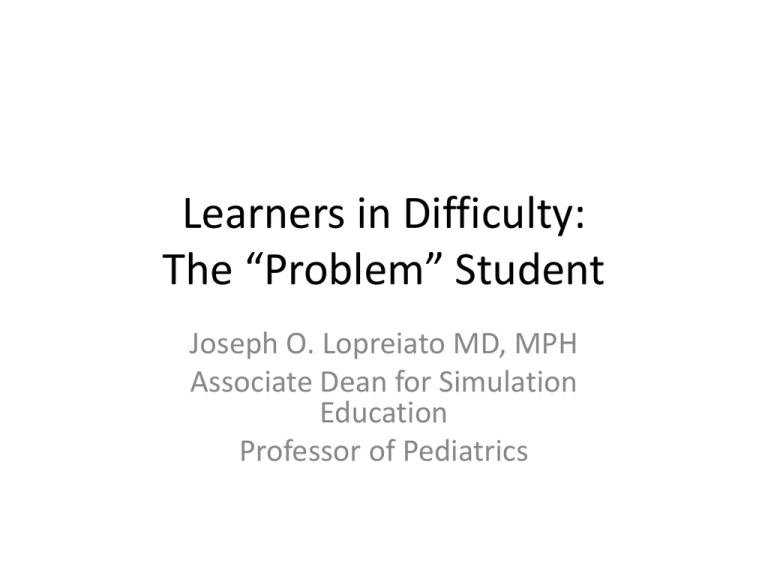
Learners in Difficulty: The “Problem” Student Joseph O. Lopreiato MD, MPH Associate Dean for Simulation Education Professor of Pediatrics Acknowledgment Drs. Catherine Lucey, Richard Hawkins and Eric Holmboe USU Student Promotions Committee Clerkship Director Residency Program Director Outline Define the problem Define the approach as a teacher Present a strategy to approach to the problem Definition ABIM • “A trainee who demonstrates a significant enough problem that requires intervention by someone of authority” Learner /School Dilemma • Conflicts: – Student advocate role – Societal and professional obligations – Institutional loyalty • Tendencies: – Minimization and temporization • Second chances • Will get better if you work harder • Difficulty in providing negative evaluation (clinical) USUHS Pre-clinical: Magnitude Fundamentals: • 98% Pass • 2% Fail or incomplete Preclerkship CPR module: • 12% Honors • 85% Pass • 2% Fail or Incomplete USUHS clinical: Magnitude Pediatrics: • 16% A • 44% B • 5% C • 3% Fail or incomplete Internal Medicine: • 25% A • 40% B • 12% C • 4% Fail or incomplete Approach to evaluation Symptoms HPI/ PMHx Differential Dx Final Dx Symptoms: Potential Problem Noted Low clinical/small group discussion rating Complaint Peer incident Low exam/quiz scores Poor OSCE performance Learner self-identified Symptoms: in Clinical Arena Direct observation in clinical setting Critical incident Poor performance at morning report Neglecting patient care responsibilities Yao and Wright, 2000 HPI/PMHx What happened? What are the circumstances Happened before? Want to talk about it? Feelings? Differential Diagnoses Organizational Causes: Knowledge Causes: (Bordage) • Study Time/Study Methods/Test taking (OSA) • Energy (motivation) • Context & Culture (engineer vs. physician) • Dispersed • Elaborated Differential Diagnoses Lucey’s Causes (7Ds): • Deprivation (sleep, relationships) • Distraction (family, money) • Depression • Dependence on drugs and alcohol • Disordered personality • Disorders of Learning (ADHD, LD) • Disease Lucey Reference ######## Depression and Anxiety Liselotte N. Academic Med 2006;81:354-373 Dependence Disorders Disease Diabetes Organic brain syndrome Thyroid disease Malignancy Eating Disorders Post Partum Depression Etc… Lucey’s Causes (7Ds): • Deprivation (sleep, relationships) • Distraction (family, money) • Depression • Dependence on drugs and alcohol • Disordered personality • Disorders of Learning (ADHD, LD) • Disease Organizational Causes: Knowledge Causes: (Bordage) • Study Time/Study Methods/Test taking (OSA) • Energy (motivation) • Context & Culture (engineer vs. physician) • Dispersed • Elaborated Self-Efficacy Artino & Bandura ◦ Choice of activities; effort; persistence * Motivation Rhoads, J of Med Ed 1974 Approach to evaluation References • Artino, A. R., Jr. (2012). Academic self-efficacy: from educational theory to instructional practice. Perspect Med Educ, 1(2), 76-85. doi: 10.1007/s40037-012-0012-5 • Croen, L. G., Woesner, M., Herman, M., & Reichgott, M. (1997). A longitudinal study of substance use and abuse in a single class of medical students. [Comparative Study]. Acad Med, 72(5), 376-381. • Dyrbye, L. N., Thomas, M. R., & Shanafelt, T. D. (2006). Systematic review of depression, anxiety, and other indicators of psychological distress among U.S. and Canadian medical students. [Review]. Acad Med, 81(4), 354-373. • Ghodasara, S. L., Davidson, M. A., Reich, M. S., Savoie, C. V., & Rodgers, S. M. (2011). Assessing student mental health at the Vanderbilt University School of Medicine. Acad Med, 86(1), 116-121. doi: 10.1097/ACM.0b013e3181ffb056 • Holmboe. (2008). Practical guide to the evaulation of clinical competence. 1st ed. • [edited by] Eric S. Holmboe, Richard E. Hawkins. Mosby/Elsevier in Philadelphia, PA . • Ishak, W., Nikravesh, R., Lederer, S., Perry, R., Ogunyemi, D., & Bernstein, C. (2013). Burnout in medical students: a systematic review. Clin Teach, 10(4), 242-245. doi: 10.1111/tct.12014 • Rhoads, J. M., Gallemore, J. L., Jr., Gianturco, D. T., & Osterhout, S. (1974). Motivation, medical school admissions, and student performance. [Comparative Study]. J Med Educ, 49(12), 1119-1127. • Rosebraugh, C. J. (2000). Learning disabilities and medical schools. Med Educ, 34(12), 9941000. • Yao, D. C., & Wright, S. M. (2000). National survey of internal medicine residency program directors regarding problem residents. JAMA, 284(9), 1099-1104. Learners in Difficulty: Therapeutic Considerations CAPT Barbara Knollmann-Ritschel Fundamentals Module Co-Directors Associate Professor for Pathology and Emerging Infectious Diseases Objectives • Identify challenges in an ongoing curriculum. • Discuss differences of short and long term remediation. • Present a strategy for learners with issues in Professionalism, Science, and Clinical Skills. • Discuss the cost of remediation. Remediation: Challenges in new Curriculum • Old Curriculum: • • • • Courses Directors Long time span with regular contact Ongoing remediation: course specific help Failed Course: repeat course/deceleration New Curriculum: New Challenges • Modules Directors: organize remediation for multiple courses with Course Directors • Ongoing curriculum- bigger impact when students are at lower end- need to juggle more courses at the same time • Less time for students with denser curriculum: • The fire hose Remediation: Challenges in new Curriculum • Remediation is spaced with ongoing curriculum– Student fails Fundamentals- final remediation may not be done until following summer! • Remediation may be 10 months later with ongoing curriculum Remediation: Challenges in new Curriculum • Timing is not ideal- what can we do? – “Pre grade remediation” – what can we do not in the short term before the end of the module or ongoing remediation – Balance with in-depth remediation REMEDIATION OF SCIENCE KNOWLEDGE VS. CLINICAL SKILLS VS. PROFESSIONALISM Are they the same? Clinical Skills Science Knowledge Professionalism Creating a Remediation Plan Review all the data, discuss with CD Talk with Student Pre-grade vs. Formal remediation How does this affect ongoing curriculum? Written plan to student and OSA Remediation of Science Knowledge: • Summary of exam results with strengths and weaknesses • Pre-remediation work summary • Reason for requiring additional work • Grade issued: Incomplete/Fail • Plan: – What type of remediation is needed and proposed study block. – A Passing score (above 65%) will be required to pass the Fundamental Module. Remediation of Clinical Skills • Review data from direct observations and Simcenter – Where is the Lesion? • • • • • Professionalism Reporter Interpreter Manager Educator • Increased time at simulation center- Practice skills – residents FNA – Remediate skills session as close to time of feedback – Focused plan on those skills that are identified as weak Remediation of Professionalism: Five-Step Approach • Major concern from AAMC Tiered Approach: 5 Step Process Email Email and Letter Email, Letter and See me Email, Letter, See me, See Commandant Email, Letter, See me, See Commandant, Formal Mentor Cost Faculty Student 1 Student 2 Acknowledgements USU Student Promotions Committee Dr. Janice Hanson Dr. Paul Hemmer
